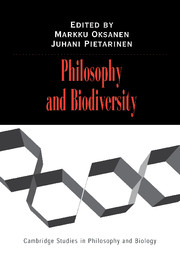Book contents
- Frontmatter
- Contents
- List of Figures and Tables
- List of Contributors
- Acknowledgements
- Philosophy and Biodiversity
- Part I USING ‘BIODIVERSITY’
- Part II UNDERSTANDING BIODIVERSITY
- 3 Plato on Diversity and Stability in Nature
- 4 Biodiversity, Darwin, and the Fossil Record
- 5 Biological Diversity, Ecological Stability, and Downward Causation
- Part III VALUING BIODIVERSITY
- Part IV PROTECTING BIODIVERSITY
- Index
- References
5 - Biological Diversity, Ecological Stability, and Downward Causation
Published online by Cambridge University Press: 26 June 2009
- Frontmatter
- Contents
- List of Figures and Tables
- List of Contributors
- Acknowledgements
- Philosophy and Biodiversity
- Part I USING ‘BIODIVERSITY’
- Part II UNDERSTANDING BIODIVERSITY
- 3 Plato on Diversity and Stability in Nature
- 4 Biodiversity, Darwin, and the Fossil Record
- 5 Biological Diversity, Ecological Stability, and Downward Causation
- Part III VALUING BIODIVERSITY
- Part IV PROTECTING BIODIVERSITY
- Index
- References
Summary
INTRODUCTION
The magnificent variety of life on Earth has astonished members of our own species ever since we arrived on the scene. Deep ecologists have honored this sense of awe by positing biological diversity as a moral end in itself. However, all of the other ethical paradigms considered by Oksanen (1997) treat biodiversity as only a means toward (and not a constituent of) “the flourishing of human and non-human life.”
Nevertheless, most experts agree that whether diversity has any intrinsic value or not, it does have a myriad of key instrumental values. For example, it facilitates the “delivery” of “ecosystem services” such as carbon dioxide absorption, flood control, and nutrient cycling (Wilson and Perlman 1999). Important as their considered judgment is on this matter, scientists have only recently gotten around to testing it through experiment, theory, and systematic observation. One candidate mechanism is the contribution of species richness (number of species) to ecological stability. Presumably, more stable ecological systems provide ecosystem services more reliably.
Given the ongoing wave of extinction wreaked by current forms of human economic activity, a revitalized research program on diversity–stability relations may seem to have come in the nick of time. However, it has encountered staunch resistance from certain quarters in ecology. In this chapter, I shall consider this research program, and challenges to it, in light of another debate, within philosophy and science: holism versus reductionism.
- Type
- Chapter
- Information
- Philosophy and Biodiversity , pp. 119 - 130Publisher: Cambridge University PressPrint publication year: 2004
References
- 7
- Cited by



